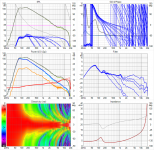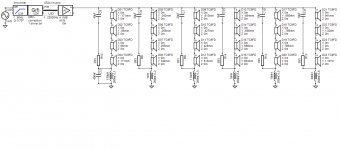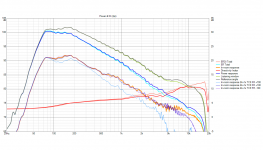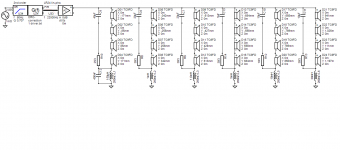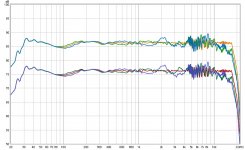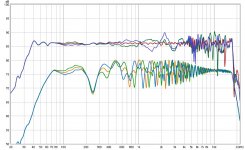Yes - I suppose I described a long and tall ESL63  but maybe it wouldn't produce a sphere as you say.. for some reason unknown to me.
but maybe it wouldn't produce a sphere as you say.. for some reason unknown to me.
Now, I don't know if I'm hit with spherical sound waves at concert hall 8th row?
I'm sure one could have quite interesting time experimenting with such a system anyway...
//
Now, I don't know if I'm hit with spherical sound waves at concert hall 8th row?
I'm sure one could have quite interesting time experimenting with such a system anyway...
//
That's the one firing in rings, right? Basically Tom made the equivalent of that in a horn shape.
While I do use a straight array, the DSP will try to make it into the right shape again. Most people say of arrays: they make everything sound huge! Well, not if you absorb early reflections, avoid diffraction and use DSP to make them behave.
They sound huge on full scale recordings, small if the recording captured that. And anything in between.
If I weren't using arrays, I'd have horns. But I'd need to have the room for them too, which is why I have arrays. Good choice? I'm not complaining!
While I do use a straight array, the DSP will try to make it into the right shape again. Most people say of arrays: they make everything sound huge! Well, not if you absorb early reflections, avoid diffraction and use DSP to make them behave.
They sound huge on full scale recordings, small if the recording captured that. And anything in between.
If I weren't using arrays, I'd have horns. But I'd need to have the room for them too, which is why I have arrays. Good choice? I'm not complaining!
Last edited:
I would be interested to see what you could come up with relaxing the wiring restrictions, if the vertical could be widened somewhat that would open up a lot more tweeter possibilities. If I was to do anything to my arrays I would most likely rebuild the whole thing as a v2 so exploring these sort of possibilities is interesting.I bet I could make an even better proposition, if I were to wire the array differently. Nah, maybe I won't take that bet, as it would involve accepting other compromises that could make it hard to achieve.
More time to sim?
If you look at the bend sims I posted, even that would be a possibility to widen the output, up to a limit. Also Crumboo's wiring scheme is a different example on how to have more ways to widen the beam.
I can't promise to try it, as I am fully committed to see my own filtered array come to life. I've spend a lot of time coming up with that, it would take me at least an equal amount of time to try another schematic.
You'd have to know the listening axis height in advance, if using a tweeter, can we do the tricks Crumboo showed, to have the design axis below the central tweeter axis? What does it do to the IR? What do the different heights look like in such a case?
I can't promise to try it, as I am fully committed to see my own filtered array come to life. I've spend a lot of time coming up with that, it would take me at least an equal amount of time to try another schematic.
You'd have to know the listening axis height in advance, if using a tweeter, can we do the tricks Crumboo showed, to have the design axis below the central tweeter axis? What does it do to the IR? What do the different heights look like in such a case?
Totally understand, I have my hands full trying to get my waveguide speaker progressing, running ribbon sims in ABEC doesn't help that either but sometimes ideas come up that are interesting enough to be distractingI can't promise to try it, as I am fully committed to see my own filtered array come to life. I've spend a lot of time coming up with that, it would take me at least an equal amount of time to try another schematic.
I'd figure it would look something like this:

(tweeter position is missing, the zero position has no driver)
Schematic:
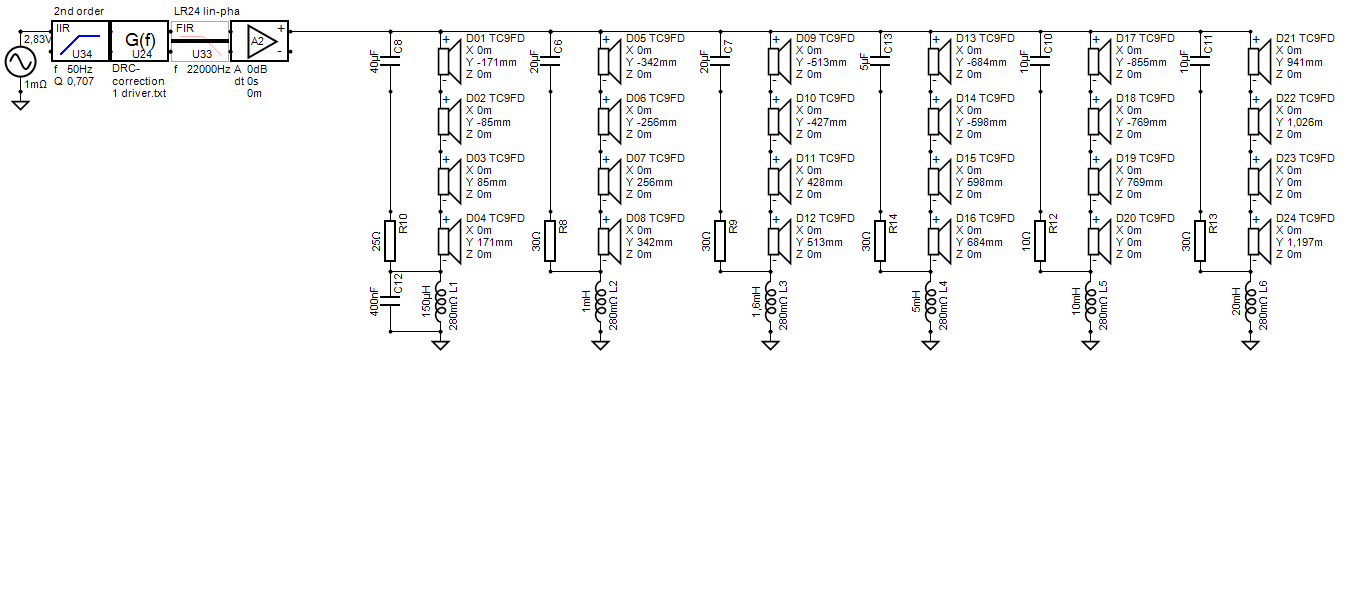
As the correction I used the FIR correction file for a single TC9.
According to line array theory, this should give me a 3 dB/octave drop, right?
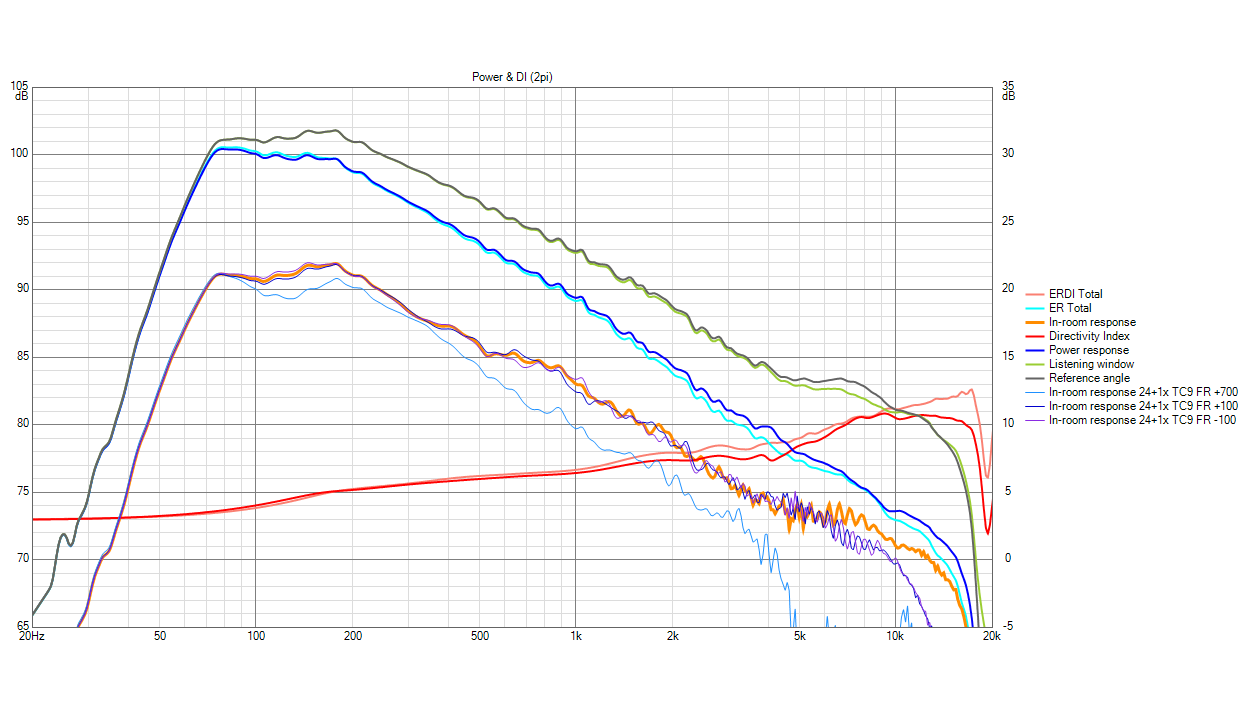
Positions 0, +100, -100 and +700 (floor and ceiling reflections on at -12 dB)
(tweeter position is missing, the zero position has no driver)
Schematic:
As the correction I used the FIR correction file for a single TC9.
According to line array theory, this should give me a 3 dB/octave drop, right?
Positions 0, +100, -100 and +700 (floor and ceiling reflections on at -12 dB)
Attachments
Last edited:
Your TC9 array has impressively wide vertical response. My copy isn't quite as good but its not apples to apples as I have different directivity files, EQ and listening distance.
But key to success in this central tweeter endeavor is a tweeter WG that controls directivity down to XO. Given fluid's fluency with ATH and ABEC, a collaboration on that would be awesome! You might need to knock out two TC9s at center for the wg...
But key to success in this central tweeter endeavor is a tweeter WG that controls directivity down to XO. Given fluid's fluency with ATH and ABEC, a collaboration on that would be awesome! You might need to knock out two TC9s at center for the wg...
To notch or not to notch...
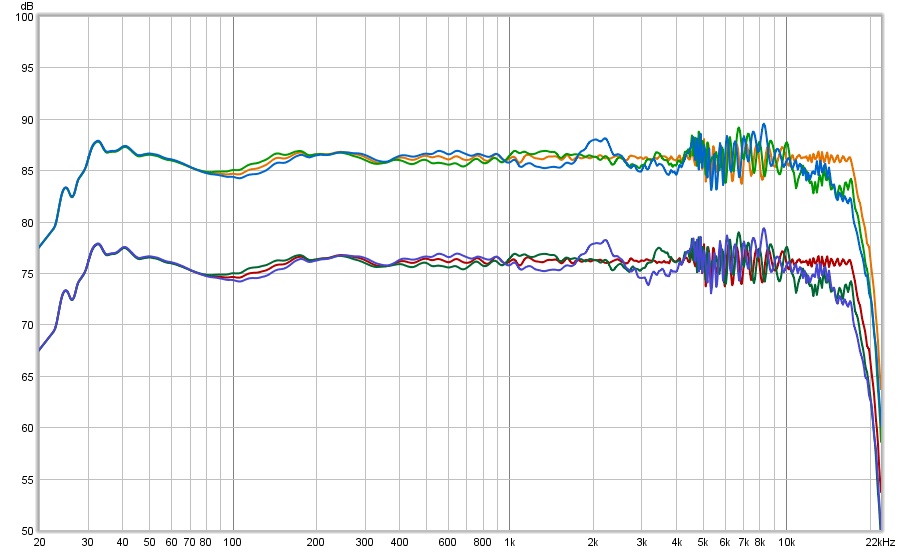
The above graph shows positions of mic heights 0 +100 and -100.
The offset of 10 dB between them is for comparing, the upper graph has 2 notches (on specific drivers, to series notches so 6 components total) added.
The idea to try this came from the alternative array as presented a couple of days ago. It showed a high degree of symmetry works well to get vertical positions more even in balance. But it's a delicate process.
As I haven't yet closed up the first speaker, it would be an option to add these two notches per array. The bigger question; would it be worth it?
The graphs are plotted with floor and ceiling reflections set to on, as in-room responses, absorption on floor and ceiling both set at -6 dB.
What can be seen is that the 3-4 KHz area is closer to the optimal center position with those notches added. The bump at ~2 KHz I cannot relieve easily, or I would have. This has to do with the floor mostly. It is the upper +100 mm mic position, you can also see a bump at 8 KHz, which is primarily there to keep a good standing outcome. Compromises/sacrifices .
.
I've checked the further position, above is the sweetspot, meaning about half a meter back. There, the 3 to 5 KHZ is more bundled as well with the notches added. (That would be the HT position on the couch )
)
About 6 extra components needed, small ones like 2 and 2,5 mH inductors, 15 and 20 Ohm resistors and a pair of 1 uF capacitors per array.
Why do I bother? Knowing we can have close to this outcome at the listening position, this area falls within the cross talk region, blind spot at ~1.8 KHz, more output at ~3.7 KHz, another smaller blind spot at 5.5 KHz and finally another small bump at 7.2 KHz. That's the biggest area that get targeted by mid/side EQ. small differences here (especially in the bumps, eg. 3.7 and 7.2) can change our perception pretty strong.
The blind spots (real dips at ear positions) are less sensitive to changes.
These details become more and more important to get right once the amount of (early) reflections is diminished. A single driver would have pretty strong floor and ceiling effects in that same region in similar circumstances. Pretty much helping to hide that cross talk. I believe that is what gives arrays their specific character compared to most other speakers. As said, i'm not talking about larger than life imaging that's mentioned so often. That disappears once we start using DSP to re-align the wave front. I'm getting at the fact that things like cross talk are more clear, but if you're successful to work around it, imaging gets a pretty strong boost from the "they are here" that most speakers get to the "you are there" kind of presentation that I prefer. Clear, open and dynamic sound with holographic properties, at least that's the potential that I hope to improve upon with these tweaks.
Any opinions?
The above graph shows positions of mic heights 0 +100 and -100.
The offset of 10 dB between them is for comparing, the upper graph has 2 notches (on specific drivers, to series notches so 6 components total) added.
The idea to try this came from the alternative array as presented a couple of days ago. It showed a high degree of symmetry works well to get vertical positions more even in balance. But it's a delicate process.
As I haven't yet closed up the first speaker, it would be an option to add these two notches per array. The bigger question; would it be worth it?
The graphs are plotted with floor and ceiling reflections set to on, as in-room responses, absorption on floor and ceiling both set at -6 dB.
What can be seen is that the 3-4 KHz area is closer to the optimal center position with those notches added. The bump at ~2 KHz I cannot relieve easily, or I would have. This has to do with the floor mostly. It is the upper +100 mm mic position, you can also see a bump at 8 KHz, which is primarily there to keep a good standing outcome. Compromises/sacrifices
I've checked the further position, above is the sweetspot, meaning about half a meter back. There, the 3 to 5 KHZ is more bundled as well with the notches added. (That would be the HT position on the couch
About 6 extra components needed, small ones like 2 and 2,5 mH inductors, 15 and 20 Ohm resistors and a pair of 1 uF capacitors per array.
Why do I bother? Knowing we can have close to this outcome at the listening position, this area falls within the cross talk region, blind spot at ~1.8 KHz, more output at ~3.7 KHz, another smaller blind spot at 5.5 KHz and finally another small bump at 7.2 KHz. That's the biggest area that get targeted by mid/side EQ. small differences here (especially in the bumps, eg. 3.7 and 7.2) can change our perception pretty strong.
The blind spots (real dips at ear positions) are less sensitive to changes.
These details become more and more important to get right once the amount of (early) reflections is diminished. A single driver would have pretty strong floor and ceiling effects in that same region in similar circumstances. Pretty much helping to hide that cross talk. I believe that is what gives arrays their specific character compared to most other speakers. As said, i'm not talking about larger than life imaging that's mentioned so often. That disappears once we start using DSP to re-align the wave front. I'm getting at the fact that things like cross talk are more clear, but if you're successful to work around it, imaging gets a pretty strong boost from the "they are here" that most speakers get to the "you are there" kind of presentation that I prefer. Clear, open and dynamic sound with holographic properties, at least that's the potential that I hope to improve upon with these tweaks.
Any opinions?
Attachments
Last edited:
No takers? Maybe if i show a comparison under the same conditions of the unshaded array and a single driver:
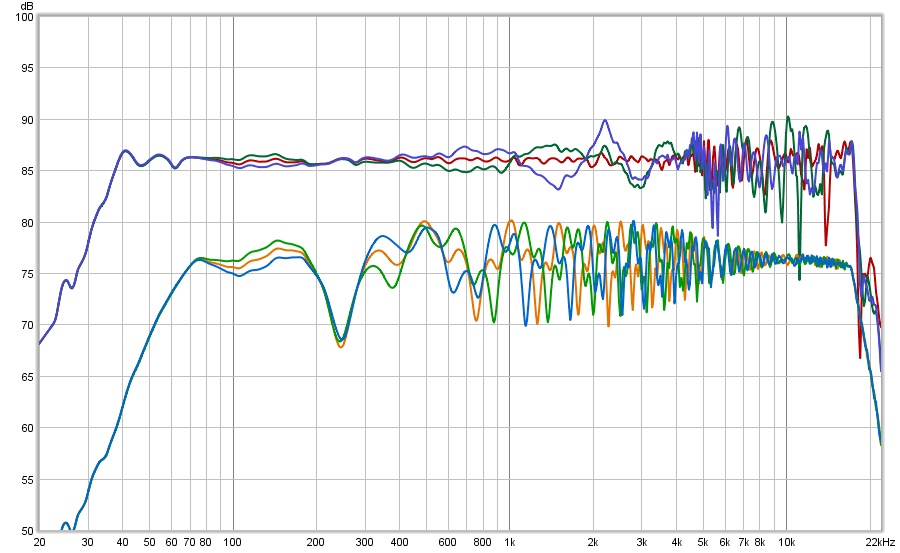
Don't mind what happens below 500 Hz, where the unshaded array looks to be having an advantage. The difference is I EQ-ed the in-room response of the two earlier examples with ceiling reflections off (accidentally).
The floor bounce of the single driver is obvious. There's a hole thread about things one can do to improve floor bounce results over in multi way. Fluid gave the answer that I think was spot on, no one seemed to care about the answer.
But here's the proof of that specific pudding.
The way I see it, these graphs with a specific absorption/reflection level set for floor and ceiling isn't what we are going to see. One may have a rug between speaker and listening spot. Another has concrete floors or hardwood. Ceilings differ too, and no material will act the same throughout the whole frequency spectrum anyway. But I do believe that residual patterns like this may clue our brain in on things like room size.
In that case, the arrays will throw that off. Being so directional over a wide bandwidth to avoid most of the reflections, it acts way different than most.
If this is an advantage or a draw back, remains to be seen. So far I've put it in the "advantage" box, which is why I try and optimize that part of its behavior.
In all honesty, I think it will be difficult to integrate a tweeter within this line of drivers without making other compromises. Even if it does seem that is the way forward to reduce that last bit of floor/ceiling influence. So that makes me wonder to include the notches, as these tweaks that I do right now may have to keep me entertained for a long time to come. I'm certainly not planning on operating the speakers on a regular basis.
Don't mind what happens below 500 Hz, where the unshaded array looks to be having an advantage. The difference is I EQ-ed the in-room response of the two earlier examples with ceiling reflections off (accidentally).
The floor bounce of the single driver is obvious. There's a hole thread about things one can do to improve floor bounce results over in multi way. Fluid gave the answer that I think was spot on, no one seemed to care about the answer.
But here's the proof of that specific pudding.
The way I see it, these graphs with a specific absorption/reflection level set for floor and ceiling isn't what we are going to see. One may have a rug between speaker and listening spot. Another has concrete floors or hardwood. Ceilings differ too, and no material will act the same throughout the whole frequency spectrum anyway. But I do believe that residual patterns like this may clue our brain in on things like room size.
In that case, the arrays will throw that off. Being so directional over a wide bandwidth to avoid most of the reflections, it acts way different than most.
If this is an advantage or a draw back, remains to be seen. So far I've put it in the "advantage" box, which is why I try and optimize that part of its behavior.
In all honesty, I think it will be difficult to integrate a tweeter within this line of drivers without making other compromises. Even if it does seem that is the way forward to reduce that last bit of floor/ceiling influence. So that makes me wonder to include the notches, as these tweaks that I do right now may have to keep me entertained for a long time to come. I'm certainly not planning on operating the speakers on a regular basis.
Attachments
Last edited:
The difference is small I was having a hard time spotting it until I read your description. Seems better if you are willing to pay for the extra parts.No takers? Maybe if i show a comparison under the same conditions of the unshaded array and a single driver:
They were having too much fun arguing with each other over who had the biggest ... no room for common sense data and examplesThere's a hole thread about things one can do to improve floor bounce results over in multi way. Fluid gave the answer that I think was spot on, no one seemed to care about the answer.
Give me a chance to try and make a driver that fits first before we write the idea off, it just started to get interestingIn all honesty, I think it will be difficult to integrate a tweeter within this line of drivers without making other compromises. Even if it does seem that is the way forward to reduce that last bit of floor/ceiling influence. So that makes me wonder to include the notches, as these tweaks that I do right now may have to keep me entertained for a long time to come. I'm certainly not planning on operating the speakers on a regular basis.
I'm not giving up on the idea  , but I'd need convincing data to see if it's worth it.
, but I'd need convincing data to see if it's worth it.
P.S. I thought of posting in that thread, but figured it was way better to let them measure up their .... and have fun with that!
I'll think about the notches. Now would be the right time to add them, it saves me rewiring the entire array. Even though there's probably enough potential in doing that too! I'll compare them without adding floor and ceiling effects too, may the best solution win.
P.S. I thought of posting in that thread, but figured it was way better to let them measure up their .... and have fun with that!
I'll think about the notches. Now would be the right time to add them, it saves me rewiring the entire array. Even though there's probably enough potential in doing that too! I'll compare them without adding floor and ceiling effects too, may the best solution win.
Its not that I didn't care or didn't notice the difference, its that I had no idea whether it would be audible. I couldn't help thinking that your endless thinking and tweaking makes you the ideal candidate for the DSP per driver solution, impracticality thereof not withstanding. Perhaps you could bring wires from each shading group of drivers to a connector to allow you to tweak without opening the cabinets back up.
Re' floor and ceiling reflections - there is additional combing that happens from them in the HF. I saw that in my fine frequency shaded sim where I had eliminated all the direct wave combing via shading. Just a thin layer of absorption on either or both should help.
I agree with your last comment re' compromise being inevitable with a central tweeter. Everything I have simulated with a crossover in it has vertical narrowing at the crossover. Central tweeter is incompatible with both seated and standing listening.
Re' floor and ceiling reflections - there is additional combing that happens from them in the HF. I saw that in my fine frequency shaded sim where I had eliminated all the direct wave combing via shading. Just a thin layer of absorption on either or both should help.
I agree with your last comment re' compromise being inevitable with a central tweeter. Everything I have simulated with a crossover in it has vertical narrowing at the crossover. Central tweeter is incompatible with both seated and standing listening.
That's hard to predict, the reason I went the filter route was that it gave better results all throughout the frequency spectrum. Not limited to the top end. If I can optimize that difference, I'll have my answer if it is an improvement. Otherwise I'll have to yank it all out again  .
.
I distinctly remember a build of an array that had all drivers with connecting points outside of the enclosure. Making it possible to rewire at will!
If I lived alone, no family to worry about, I would have done something like that .
.
I'm taking a gamble here that these filters are an improvement, and taking it a notch up (pun intended) is possible while I wait for better weather to allow me to work in the garage again. But this will be it for a while, as it will take a long time to see if the improvements in graphs lead to improvements in listening.
In DSP alone there are so many options to make it sound different, its going to take time to try it all!
I share those worries about a crossover. If it doesn't work out I may consider an alternative path with ambience tweeters placed behind the arrays (properly delayed). Something I've also wanted to try.
I distinctly remember a build of an array that had all drivers with connecting points outside of the enclosure. Making it possible to rewire at will!
If I lived alone, no family to worry about, I would have done something like that
I'm taking a gamble here that these filters are an improvement, and taking it a notch up (pun intended) is possible while I wait for better weather to allow me to work in the garage again. But this will be it for a while, as it will take a long time to see if the improvements in graphs lead to improvements in listening.
In DSP alone there are so many options to make it sound different, its going to take time to try it all!
I share those worries about a crossover. If it doesn't work out I may consider an alternative path with ambience tweeters placed behind the arrays (properly delayed). Something I've also wanted to try.
- Home
- Loudspeakers
- Full Range
- The making of: The Two Towers (a 25 driver Full Range line array)
